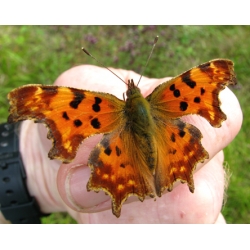- Current EGGS and LARVAE (54)
- EXOTIC BUTTERFLY PUPAE (11)
- MARKET STALL Everything a BARGAIN! (22)
- XXP super fast EXPRESS COURIER DELIVERY (2)
- CURRENT PUPAE - Chrysalides and cocoons (45)
- SILKWORM EGGS and Silkworms (6)
- SPRING and SUMMER EGGS and LARVAE Order now for supply in season (73)
- SPRING and SUMMER PUPAE You can order these NOW in advance (25)
- GIFT SUGGESTIONS (29)
- WINTER PUPAE for breeding in the following season (30)
- CAGES (10)
- PHASMIDS Leaf & Stick Insects, Mantids and more (2)
- SCHOOLS Recommended Livestock (14)
- SLEEVES for REARING LARVAE (7)
- PLASTIC REARING CONTAINERS (2)
- EQUIPMENT (29)
- MOTH TRAPS (7)
- NETTING (3)
- BOOKS (39)
- CHARTS (21)
- SPECIMENS for collectors (151)
- SILK Yarn, Fibres, Silkworm eggs (7)
Comma Butterfly Polygonia c-album
Fascinating larvae with curious half and half markings in black, brown and white, mimicking a bird dropping. The larvae feed on Stinging Nettle, Elm and Hop. Also Sallow, Osier Willow Salix viminalis, and sometimes other Willows. They live singly. Fast growing.
Young larvae will succeed best if placed on growing foodplant. Enclose plant and pot in a netting sleeve, tied at both ends: size 3 is ideal. Otherwise you can sleeve Comma larvae on branches of Elm, Sallow and Willows, including Osier. Good ventilation is required. Cut food is not recommended at least until the larvae are nearly half grown. Comma larvae do not like crowding, and do best kept so that each caterpillar can get away and live on its own. Disease can occur if conditions are not perfect. If it does, it helps that the larvae live separately. Any infected or dead larvae should be removed and disinfection should be carried out, lightly spraying 10% bleach solution, which will not affect healthy larvae, but does help prevent the spread of disease.
This garden butterfly is capable of re-colonising places where it used to be. In autumn the butterflies are very partial to fallen fruit. With some help this butterfly could be encouraged to spread.
Keeping two species of larvae together on the same foodplant? It is sometimes possible, but their way of life may differ and we recommend keeping them separately. Comma larvae live solitary lives and should be reared in their own enclosure.










